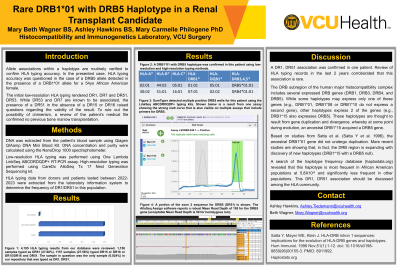Back

Rare DRB1*01 with DRB5 Haplotype
(P405) Rare DRB1*01 with DRB5 haplotype
Location: Platinum Ballroom

Poster Presenter(s)
Body: To confirm the accuracy of an HLA typing, laboratory professionals include verification of association between alleles within a haplotype. The accuracy of an HLA typing was questioned in the case of a DRB5 allele detected in presence of a DRB1*01 allele for a 54yo African American female. The initial low-resolution HLA typing for the patient (figures 1 and 2) rendered DR1, DR7 and DR51, DR53. While DR53 and DR7 are known associations, the presence of a DR51 in the absence of a DR15 or DR16 raised questions regarding the validity of the result. A review of the patient’s medical file confirmed no previous bone marrow transplantation. The frequency of DR1/DR51 was assessed by extracting 2022-2023 HLA typing from our database. Of 3,141 HLA typing results reviewed, 822 samples typed as DR51; 26.17% and 26.14% respectively were DR15 or DR16 or DR15/DR16 and DR51. Based on the statistical evidence showing absence of association between DR1 and DR51 in our cohort, additional testing was initiated. Low resolution HLA typing was repeated using One Lambda LinkSeq ABCDRDQDP+ RT-PCR assay. High resolution typing was performed using AlloSeq CareDx kit. Figure 2 shows two DR1 positive and two DR51 positive wells with DRB5*01 primers based on RT-PCR. High-resolution testing confirmed the presence of DR51 (Figure 3). Figure 4 shows presence of sequence for DRB5 (DR51) in core exons with robust Mean Read Depth of 195 (acceptable Mean Read Depth is 50 for hemizygous loci).
Conclusion: The DR1, DR51 association was confirmed by our testing. A search of the haplotype frequency database (haplostats.org) showed a very low frequency in African American populations (5.8X10-8) and significantly less frequent in other populations. The DRB subregion of the human MHC includes several expressed DRB genes (DRB1, DRB3, DRB4, and DRB5). While some haplotypes express only one of these genes (DRB1*01, DRB1*08 or DRB1*10), other haplotypes express 2 of the genes (DRB1*15 also expresses DRB5). It is thought that the origin of these haplotypes results from gene duplication and divergence, whereby at some point during evolution, an ancestral DRB1*15 acquired a DRB5 gene. Based on studies in 1996 (Satta Y et al 1996), the ancestral DRB1*01 gene did not undergo duplication. More recent studies are showing that in fact the DRB region is expanding with discovery of new haplotypes (DRB1*15 with a DRB5 null). This DR1, DR51 association should be discussed among the HLA community.
Conclusion: The DR1, DR51 association was confirmed by our testing. A search of the haplotype frequency database (haplostats.org) showed a very low frequency in African American populations (5.8X10-8) and significantly less frequent in other populations. The DRB subregion of the human MHC includes several expressed DRB genes (DRB1, DRB3, DRB4, and DRB5). While some haplotypes express only one of these genes (DRB1*01, DRB1*08 or DRB1*10), other haplotypes express 2 of the genes (DRB1*15 also expresses DRB5). It is thought that the origin of these haplotypes results from gene duplication and divergence, whereby at some point during evolution, an ancestral DRB1*15 acquired a DRB5 gene. Based on studies in 1996 (Satta Y et al 1996), the ancestral DRB1*01 gene did not undergo duplication. More recent studies are showing that in fact the DRB region is expanding with discovery of new haplotypes (DRB1*15 with a DRB5 null). This DR1, DR51 association should be discussed among the HLA community.

